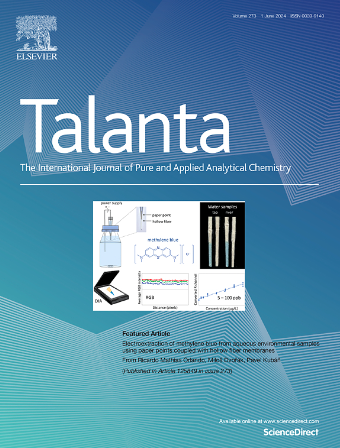A novel nanomotor (ZIF-L(Co)/WSe2 nanocomposite) for nanomotor motion-based dispersive micro-solid phase extraction (NM-d-μSPE) of gold and palladium
IF 5.6
1区 化学
Q1 CHEMISTRY, ANALYTICAL
引用次数: 0
Abstract
A novel method for the separation and enrichment of Au(III) and Pd(II) ions in mining stone and covering samples was developed, using ZIF-L(Co)/WSe2 as a nanomotor for nanomotor motion-based dispersive micro-solid phase extraction (NM-d-μSPE). The manufactured nanocomposite was characterized using X-ray diffraction (XRD), Fourier-transform infrared spectroscopy (FTIR), field emission scanning electron microscopy (FE-SEM), and electrochemical analyses. The motion dynamics of the nanomotor have been optimized by modifying the concentration of the fuel (H2O2) to achieve rapid and efficient movement, which enhanced adsorption performance. Important analytical parameters, such as pH, ligand and sorbent amounts, eluent type and volume, and the influence of matrix ions, were methodically studied. The method exhibited excellent sensitivity, with detection and quantification limits of 0.93 μg L−1 and 3.10 μg L−1 for Au(III) and 0.83 μg L−1 and 2.76 μg L−1 for Pd(II), respectively. The ZIF-L(Co)/WSe2 nanomotor showed exceptional adsorption efficiency for the simultaneous extraction of Au(III) and Pd(II) ions in the presence of H2O2 fuel. This method is reliable, fast, and simple, thus offering a useful method for the separation, enrichment, and quantification of Au(III) and Pd(II) in geological samples using flame atomic absorption spectroscopy (FAAS). Additionally, inductively coupled plasma-mass spectrometry (ICP-MS) was used to validate the NM-d-μSPE method.

求助全文
约1分钟内获得全文
求助全文
来源期刊

Talanta
化学-分析化学
CiteScore
12.30
自引率
4.90%
发文量
861
审稿时长
29 days
期刊介绍:
Talanta provides a forum for the publication of original research papers, short communications, and critical reviews in all branches of pure and applied analytical chemistry. Papers are evaluated based on established guidelines, including the fundamental nature of the study, scientific novelty, substantial improvement or advantage over existing technology or methods, and demonstrated analytical applicability. Original research papers on fundamental studies, and on novel sensor and instrumentation developments, are encouraged. Novel or improved applications in areas such as clinical and biological chemistry, environmental analysis, geochemistry, materials science and engineering, and analytical platforms for omics development are welcome.
Analytical performance of methods should be determined, including interference and matrix effects, and methods should be validated by comparison with a standard method, or analysis of a certified reference material. Simple spiking recoveries may not be sufficient. The developed method should especially comprise information on selectivity, sensitivity, detection limits, accuracy, and reliability. However, applying official validation or robustness studies to a routine method or technique does not necessarily constitute novelty. Proper statistical treatment of the data should be provided. Relevant literature should be cited, including related publications by the authors, and authors should discuss how their proposed methodology compares with previously reported methods.
 求助内容:
求助内容: 应助结果提醒方式:
应助结果提醒方式:


